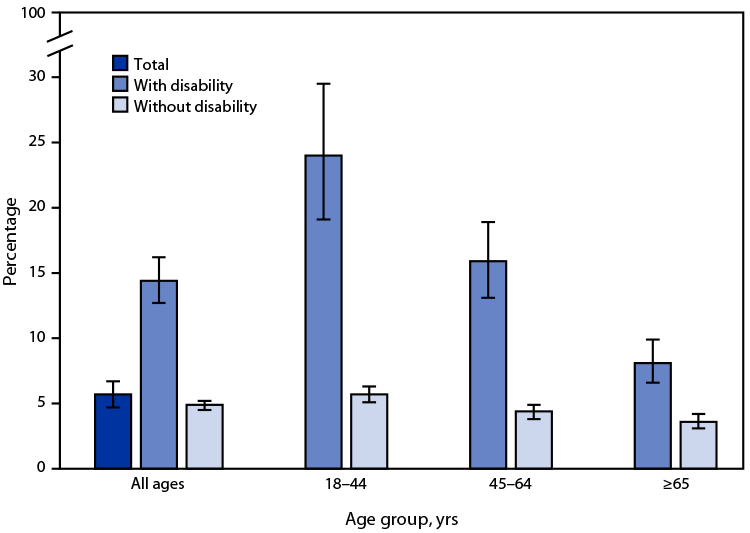QuickStats: Percentage* of Adults Aged ≥18 Years Who Lacked Reliable Transportation for Daily Living in the Past 12 Months,† by Disability Status§ and Age Group — National Health Interview Survey, United States, 2022¶
Weekly / February 22, 2024 / 73(7);152
Altmetric:

* With 95% CIs indicated by error bars.
† Based on a response of “yes” to the question, “In the past 12 months, has a lack of reliable transportation kept you from medical appointments, meetings, work, or from getting things you needed for daily living?”
§ Disability was defined by the reported level of difficulty in response to questions about six domains of functioning: “Do you have any difficulty… seeing, even if wearing glasses; hearing, even if wearing hearing aids; walking or climbing stairs; communicating, for example understanding or being understood; remembering or concentrating; and self-care, such as washing all over or dressing.” Response categories were “no difficulty,” “some difficulty,” “a lot of difficulty,” or “cannot do at all.” Adults who responded “a lot of difficulty” or “cannot do at all” to at least one domain were classified with disability.
¶ Estimates are based on household interviews of a sample of the civilian, noninstitutionalized U.S. population.
In 2022, 5.7% of adults aged ≥18 years lacked reliable transportation for daily living in the past 12 months. The percentage lacking reliable transportation for daily living among those with disability was higher (14.4%) compared with those without disability (4.9%). The percentages among persons with disability were higher than percentages among those without disability in all age groups (18–44 years: 24.0% versus 5.7%; 45–64 years: 15.9% versus 4.4%; and ≥65 years: 8.1% versus 3.6%). Regardless of disability status, the percentage of adults who lacked reliable transportation for daily living decreased with increasing age.
Source: National Center for Health Statistics, National Health Interview Survey, 2022. https://www.cdc.gov/nchs/nhis/index.htm
Reported by: Amanda E. Ng, PhD, qkd2@cdc.gov; Dzifa Adjaye-Gbewonyo, PhD; James Dahlhamer, PhD.
Suggested citation for this article: QuickStats: Percentage of Adults Aged ≥18 Years Who Lacked Reliable Transportation for Daily Living in the Past 12 Months, by Disability Status and Age Group — National Health Interview Survey, United States, 2022. MMWR Morb Mortal Wkly Rep 2024;73:152. DOI: http://dx.doi.org/10.15585/mmwr.mm7307a4.
MMWR and Morbidity and Mortality Weekly Report are service marks of the U.S. Department of Health and Human Services.
Use of trade names and commercial sources is for identification only and does not imply endorsement by the U.S. Department of
Health and Human Services.
References to non-CDC sites on the Internet are
provided as a service to MMWR readers and do not constitute or imply
endorsement of these organizations or their programs by CDC or the U.S.
Department of Health and Human Services. CDC is not responsible for the content
of pages found at these sites. URL addresses listed in MMWR were current as of
the date of publication.
All HTML versions of MMWR articles are generated from final proofs through an automated process. This conversion might result in character translation or format errors in the HTML version. Users are referred to the electronic PDF version (https://www.cdc.gov/mmwr) and/or the original MMWR paper copy for printable versions of official text, figures, and tables.
Questions or messages regarding errors in formatting should be addressed to mmwrq@cdc.gov.